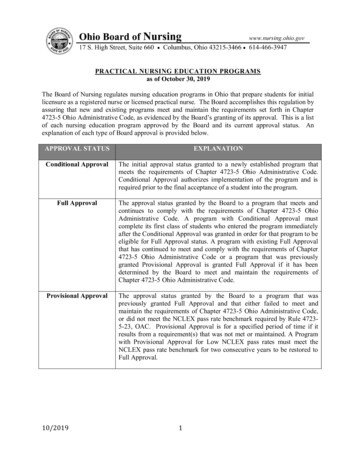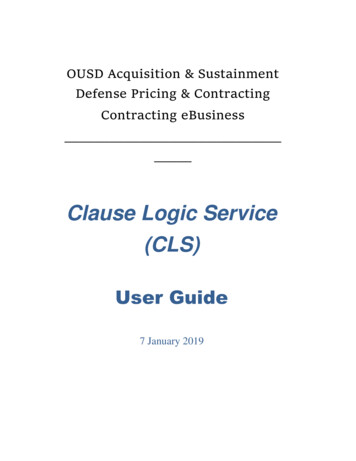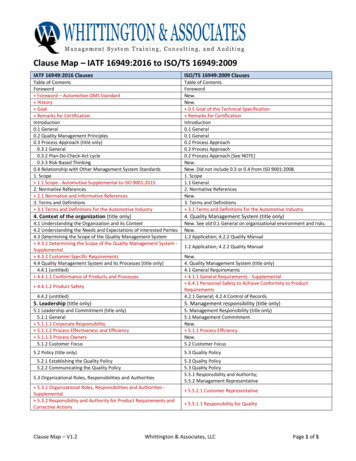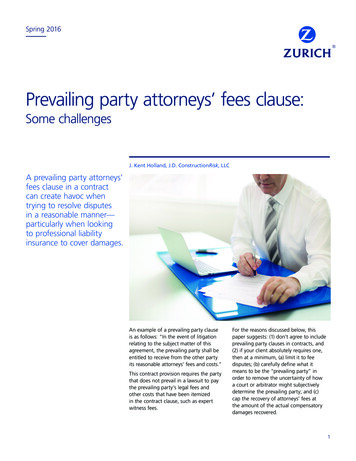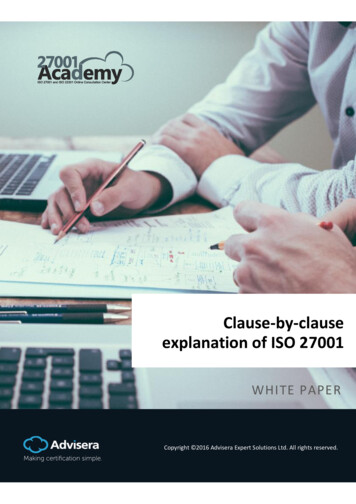
Transcription
Clause-by-clauseexplanation of ISO 27001WHITE PAPERCopyright 2016 Advisera Expert Solutions Ltd. All rights reserved.Copyright 2016 Advisera Expert Solutions Ltd. All rights reserved.1
Table of ContentsExecutive summary.30.Introduction .41.Process and process approach .52.Process approach impact .63.The Plan-Do-Check-Act cycle .74.Context of the organization .85.Leadership .96.Planning .117.Support .138.Operation .159.Performance evaluation .1610. Improvement .18Annex A – Reference control objectives and controls .19Conclusion .24Sample of documentation templates or toolkits .24References .25Copyright 2016 Advisera Expert Solutions Ltd. All rights reserved.2
Executive summaryAddressing information security risks in order to improve an organization's results is a matter of beingwell prepared. This white paper is designed to assist top management and employees from organizationsthat have decided to properly protect information by establishing and maintaining an ISO 27001:2013based Information Security Management System (ISMS).In this document, you will find an explanation of each clause of ISO 27001, from sections 4 to 10, and thecontrol objectives and security controls from Annex A, to facilitate understanding of the standard. Theclauses’ presentation is in the same order and number of the clauses as the ISO 27001:2013 standarditself. Furthermore, you’ll find links to additional learning materials like articles and other white papers.Please note: This white paper is not a replacement for ISO 27001 – to get the standard, visit the ISOwebsite: http://www.iso.orgCopyright 2016 Advisera Expert Solutions Ltd. All rights reserved.3
0. IntroductionInformation security systems are often regarded by organizations as simple checklists or policies andprocedures that deny them a lot of things, far from the way they do their normal business. By sticking tothese beliefs, organizations prevent themselves from properly building an ISMS (Information SecurityManagement System) and achieving its full potential, either in operational and financial performance, ormarketing reputation.Fortunately, there are many frameworks on the market that can help organizations to handle thissituation, among them being ISO 27001:2013.Whether standing alone or integrated with another management system, such as ISO 9001 (Quality), ISO22301 (Information Security), ISO 14001 (Environment), or OHSAS 18001 (Operational Health and Safety),the ISO 27001:2013 standard provides guidance and direction for how an organization, regardless of itssize and industry, should manage information security and address information security risks, which canbring many benefits not only to the organization itself, but also to clients, suppliers, and other interestedparties.But, for those unfamiliar with ISO standards or information security concepts, ISO 27001 may beconfusing, so we developed this white paper to help you get inside this world.Sections 1 to 3 will cover the concepts of process, process approach, and PDCA cycle applicable to ISOmanagement standards, as well as the most important definitions a beginner in information securityshould know.The main content of this white paper will follow the same order and numbering of the following clausesrequired to certify an ISMS against ISO 27001:2013:4.5.6.7.8.9.10.Context of the ormance evaluationImprovementAdditionally, the white paper also covers the content of Annex A, control objectives and security controls(safeguards), numbered from A.5 to A.18.Besides all this explanatory information, you will find throughout this white paper references to otherlearning materials.Copyright 2016 Advisera Expert Solutions Ltd. All rights reserved.4
1. Process and process approach1.1 Terms and definitionsProcess: a group of repeatable and interrelated activities performed to transform a series of inputs intodefined outputs.Process approach: management of a group of processes together as a system, where the interrelationsbetween processes are identified and the outputs of a previous process are treated as the inputs of thefollowing one. This approach helps ensure the results of each individual process will add business valueand contribute to achieve the final desired results.Information security: processes, methodologies, and technologies with the objective to preserve theconfidentiality, integrity, and availability of information.Confidentiality: property of the information that can be accessed or disclosed only to authorized persons,entities, or processes.Integrity: property of something that is complete and free of error.Availability: property of something that is accessible and usable only by an authorized person, entity, orprocess when demanded.Information security management: management of processes that cover the identification of situationsthat may put information at risk, and the implementation of controls to address those risks and protectthe interest of the business and other relevant interested parties (e.g., customers, employees, etc.).Risk: the effect of uncertainty upon desired results.Risk assessment (RA): a process that helps identify, analyze, and evaluate risks.Risk treatment plan: a set of procedures, methodologies, and technologies applied to modify risks.Residual risk: the value of a risk after risk treatment.Copyright 2016 Advisera Expert Solutions Ltd. All rights reserved.5
2. Process approach impactCompliance with the ISO 27001:2013 standard is mandatory for certification, but compliance alonedoesn’t guarantee the capacity of an organization to protect information. It’s necessary to create a robustlink between requirements, policies, objectives, performance, and actions. And that’s why a processapproach, as defined in the previous section, is so useful to implementing an ISMS.The following diagram presents some examples of inputs, outputs, and activities involved in the riskmanagement process, a cornerstone of an ISO 27001 Information Security Management System,demonstrating how a process approach is a good way to organize and manage information securityprocesses to create value for an organization and other interested parties.So, by adopting a process approach for information security, an organization can have a better view ofhow each step contributes to the main objectives of protecting information, allowing it to quickly identifyproblematic points in performing the process.Copyright 2016 Advisera Expert Solutions Ltd. All rights reserved.6
3. The Plan-Do-Check-Act cycleSince any business is a living thing, changing and evolving because of internal and external influences, itis necessary that the Information Security Management System also be capable of adjusting itself (e.g.,objectives and procedures) to follow business changes and remain relevant and useful. The ISO27001:2013 standard ensures this condition is achieved by adopting a “Plan-Do-Check-Act” cycle (PDCA)in its framework, which can be described as follows:Plan: the definition of policies, objectives, targets, controls, processes, and procedures, as well asperforming the risk management, which support the delivery of information security aligned with theorganization’s core business.Do: the implementation and operation of the planned processes.Check: the monitoring, measuring, evaluation, and review of results against the information securitypolicy and objectives, so corrective and/or improvement actions can be determined and authorized.Act: the performing of authorized actions to ensure the information security delivers its results and canbe improved.It should be noted that the PDCA cycle is a globally recognized management system methodology that isused across various business management systems, but its use is both compulsory and highly beneficialwithin ISO 27001:2013.Copyright 2016 Advisera Expert Solutions Ltd. All rights reserved.7
4. Context of the organization4.1 Understanding the organization and its contextThis clause requires the organization to determine all internal and external issues that may be relevant toits business purposes and to the achievement of the objectives of the ISMS itself.4.2 Understanding the needs and expectations of interestedpartiesThe standard requires the organization to assess who the interest parties are in terms of its ISMS, whattheir needs and expectations may be, which legal and regulatory requirements, as well as contractualobligations, are applicable, and consequently, if any of these should become compliance obligations.Tip: For more information on this topic, see the article: How to identify interested parties according toISO 27001 and ISO 22301.4.3 Determining the scope of the Information SecurityManagement SystemThe scope and boundaries and applicability of the ISMS must be examined and defined considering theinternal and external issues, interested parties’ requirements, as well as the existing interfaces anddependencies between the organization’s activities and those performed by other organizations.The scope must be kept as “documented information.”Tip: For more information on this topic, see the article: How to define the ISMS scope.4.4 Information Security Management SystemThe standard indicates that an ISMS should be established and operated and, by using interactingprocesses, be controlled and continuously improved.Copyright 2016 Advisera Expert Solutions Ltd. All rights reserved.8
5. Leadership5.1 Leadership and commitmentTop management and line managers with relevant roles in the organization must demonstrate genuineeffort to engage people in the support of the ISMS.For more information on this topic, please see the article: Roles and responsibilities of top managementin ISO 27001 and ISO 22301.This clause provides many items of top management commitment with enhanced levels of leadership,involvement, and cooperation in the operation of the ISMS, by ensuring aspects like: information security policy and objectives’ alignment with each other, and with the strategicpolicies and overall direction of the business;information security activities’ integration with other business systems where applicable;provision for resources so the ISMS can be operated efficiently;understanding of the importance of information security management and compliance with ISMSrequirements;achievement of ISMS objectives;definition of information security responsibilities to people within the ISMS, and their correctsupport, training, and guidance to complete their tasks effectively;support of the ISMS during all its life cycle, considering a PCDA approach and continualimprovement.5.2 PolicyTop management has the responsibility to establish an information security policy, which is aligned withthe organization’s purposes and provides a framework for setting information security objectives,including a commitment to fulfill applicable requirements and the continual improvement of the ISMS.The information security policy must be maintained as documented information, be communicatedwithin the organization, and be available to all interested parties.For more information on this topic, please see the article: What should you write in your InformationSecurity Policy according to ISO 27001?Copyright 2016 Advisera Expert Solutions Ltd. All rights reserved.9
5.3 Organizational roles, responsibilities and authoritiesThe standard states that it is the responsibility of top management to ensure that roles, responsibilities,and authorities are delegated and communicated effectively. The responsibility shall also be assigned toensure that the ISMS meets the terms of the ISO 27001:2013 standard itself, and that the ISMSperformance can be accurately reported to top management.For more information on this topic, please see the article: What is the job of Chief Information SecurityOfficer (CISO) in ISO 27001?Copyright 2016 Advisera Expert Solutions Ltd. All rights reserved.10
6. Planning
the ISO 27001:2013 standard provides guidance and direction for how an organization, regardless of its size and industry, should manage information security and address information security risks, which can bring many benefits not only to the organization itself, but also to clients, suppliers, and other interested parties. But, for those unfamiliar with ISO standards or information security .

